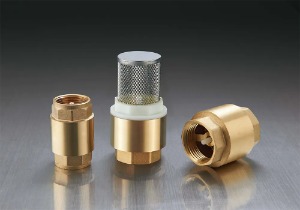2025-08-15
The core material of a brass check valve is, naturally, brass. Brass is an alloy primarily composed of copper and zinc, with the exact proportions influencing its properties. The copper content typically ranges from 55% to 70%, while zinc makes up many of the remainder. Sometimes, small amounts of other metals such as lead, tin, or iron are added to improve machinability or corrosion resistance. The choice of brass alloy affects the valve's strength, corrosion resistance, and ease of processing.

Brass is favored for check valve construction due to several properties. It offers good corrosion resistance, especially against water and many chemicals commonly found in plumbing and industrial applications. Brass also has good machinability, allowing for precise manufacturing of intricate valve components like the seat, disc, and body. Moreover, brass exhibits thermal conductivity and moderate strength, making it suitable for both residential and industrial settings.
The manufacturing process of brass check valves begins with the casting of the brass material. Common casting methods include sand casting, investment casting, and die casting. Sand casting involves pouring molten brass into a sand mold, which can produce complex shapes at a reasonable cost but often requires additional machining for precision surfaces. Investment casting offers better surface finish and dimensional accuracy, useful for smaller or more intricate valve components. Die casting is typically used for high-volume production, delivering repeatability and smooth finishes.
After casting, the valve components undergo machining processes to achieve the required dimensions and tolerances. Machining is critical for parts like the valve seat and disc, where a tight seal must be maintained to prevent leaks. Precision lathes, milling machines, and CNC equipment are used to produce smooth, accurate surfaces. The threaded connections for pipe attachment are also cut during machining, ensuring compatibility with standard piping systems.
An important part of the brass check valve is the valve seat, which must provide a secure seal when the valve closes. The seat is often machined integrally with the valve body or produced as a separate component from brass or other compatible materials such as stainless steel or rubber inserts. These inserts improve sealing performance and durability under varying pressures and temperatures.
The surface finishing of brass check valve components plays a significant role in performance and durability. After machining, components may undergo polishing to reduce surface roughness, wear and improving flow characteristics. Some manufacturers apply plating or coating treatments, such as nickel or chrome plating, to further enhance corrosion resistance and aesthetic appeal, especially in valves used in visible plumbing fixtures.
Assembly of the brass check valve involves fitting the valve disc, seat, springs (if applicable), and seals into the machined body. Seals and gaskets are often made from elastomer materials compatible with the fluid and temperature range of the application. The valve must be assembled with precision to ensure free movement of the disc and tight sealing when closed.
Testing is a critical step in the manufacturing process of brass check valves. Each valve undergoes pressure testing to verify it withstands operating pressures without leaking or failing. Functional tests ensure the valve opens and closes properly, allowing flow in one direction and preventing backflow. Leak tests are performed using water, air, or other test media depending on the valve's intended use.